Last weekend the Bundesliga finally returned after a long break due to the corona crisis. While last week we got with Borussia Dortmund vs Schalke 04 probably the greatest derby in the history of German football, this week Hertha Berlin will meet Union Berlin in the Olympiastadion. Normally this game would be especially interesting due to the atmosphere in the stadium as it is the derby of Berlin. However, without the fans, it will be quite interesting to see if the players can keep their emotions under control since it is for both teams an important game. Hertha BSC Berlin have got 31 points (11th position) after the opening 26 games while Union Berlin have collected one less (12th position).
But while the margin between Hertha and the seventh position (last one to qualify for the UEFA Europa League) is only six points, Union Berlin is just seven points ahead of Fortuna Düsseldorf and therefore the 16th place (relegation spot). In other words, the season can go either way for both teams and this derby could be a decisive game as the winner could go into the next weeks with a lot more self-confidence and momentum.
In this preview in the form of a tactical analysis, we look at both teams’ performances in their respective games last weekend to then examine what this could mean for tomorrow’s clash between them in the derby of Berlin.
Their line-ups
Since both teams performed quite well last week in their respective games, we can expect them to use about the same starting eleven. Also, no player is suspended and the injured ones won’t return for this game. Therefore, in this tactical preview, we will use the eleven players from each team as they played last weekend. There is only one change which could be likely as Sebastian Andersson probably replaces Anthony Ujah, but we will talk about this in more detail later on in this tactical analysis.
Hertha Berlin used in their 3-0 victory over Hoffenheim a 4-4-2 formation with Rune Jarstein between the sticks and a back four which consisted of Marvin Plattenhardt, Jordan Torunarigha, Dedryck Boyata, and Peter Pekarík. Marko Grujić and Per Ciljan Skjelbred were the central midfielders. Maximilian Mittelstädt and Dodi Lukébakio played in the wide areas while Matheus Cunha and Vedad Ibišević were the two strikers.
Union Berlin lost 2-0 against Bayern Munich, but played way better than the result would tell. Rafal Gikiewicz was the goalkeeper and had five defenders in front of him in Christopher Trimmel, Florian Hübner, Keven Schlotterbeck, Neven Subotić, and Christopher Lenz. Marius Bülter and Marcus Ingvartsen were the wingers while Robert Andrich and Grischa Prömel played in the central midfield. Ujah was the only striker. We will now look at both teams’ tactics in the respective games to see how the derby could look like
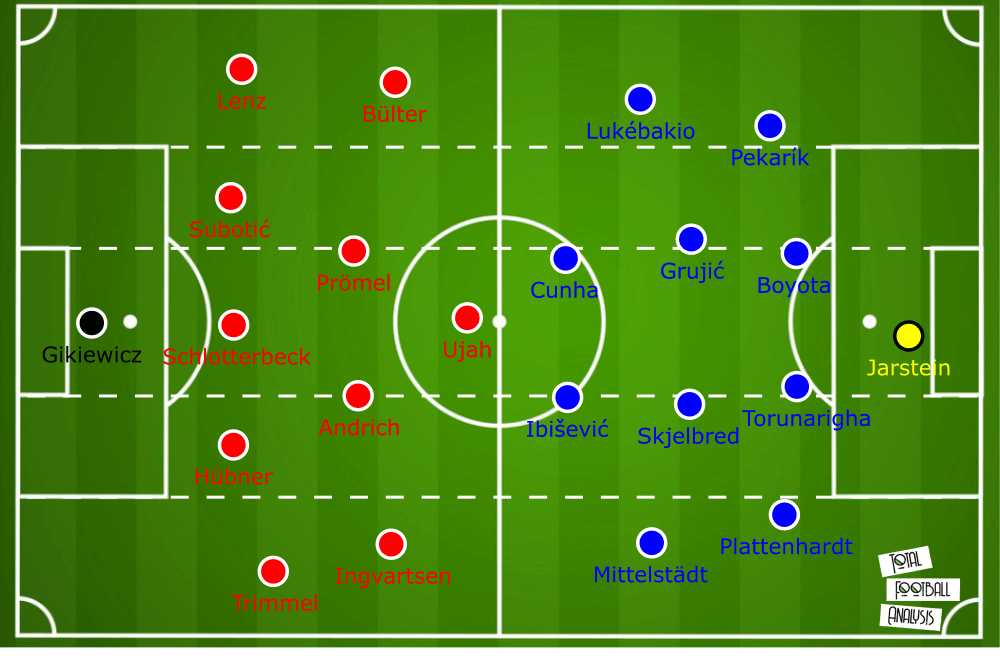
Union’s man-orientation and the area Hertha could exploit
Throughout this tactical analysis, we need to consider that Union Berlin faced Bayern Munich who have a higher individual quality compared to Hertha, but we can still expect Berlin to play with similar tactics. The team of Urs Fischer have on average 40.8% possession which is the second-lowest value of all teams in the Bundesliga and due to that, we can expect once more that they will defend deeper.
Union Berlin defended in their 5-4-1 formation and Ujah mostly started to put pressure on the opposing centre-backs at about the halfway line. The height of the pressing line changed throughout the game slightly as there were periods when Union tried to play riskier and in other moments Bayern were just so dominant that they forced them even further back.
Overall, one aspect which stood out extremely was how man-orientated they defended. In the shot below we can see them in their 5-4-1 formation and how almost every player had a direct opponent.
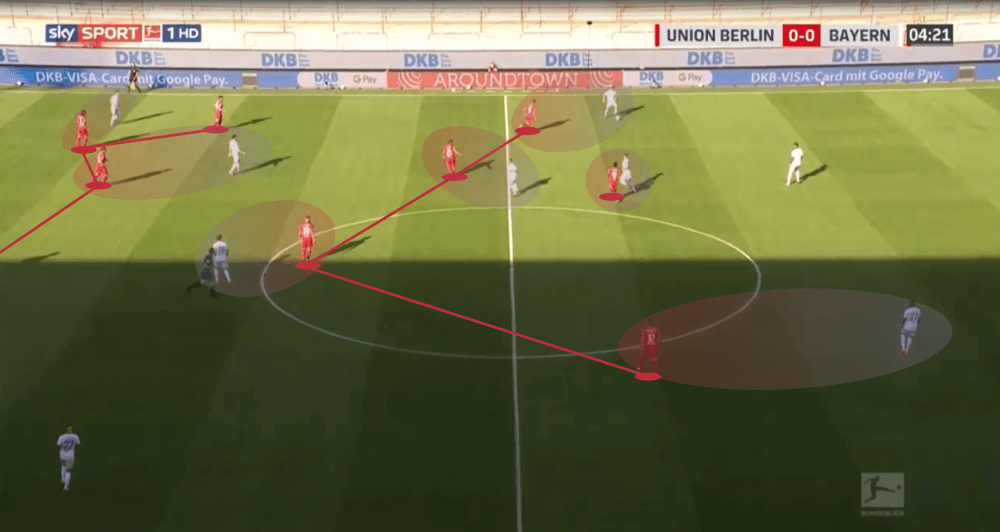
Union Berlin did quite well for huge parts of this match since whenever a Bayern player sprinted into a new area, they communicated with each other well and then the allocation changed. So, for example, when Bayern’s right-winger Thomas Müller moved into the centre, the left wing-back stopped to follow him and told the left centre-back that it would be now his task to mark the Bavarian. We can see an example of the rotation of Bayern’s players in the shot below, but still, every player of Munich has a direct opponent.
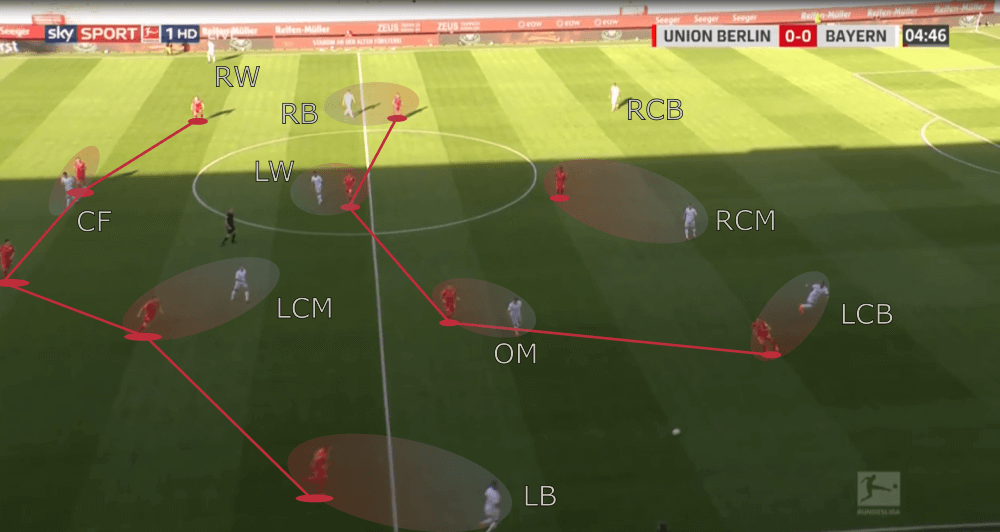
When you face an opponent who operates in such a man-orientated fashion, the central task is always to force the opposition into situations in which they have to make a decision. The reason for that is that a player can’t always take the right option and the more often you force him into such situations, the more often he makes mistakes which you can exploit.
Considering this, rotations and movements are vital to overcoming a defence which defends as man-orientated as Union Berlin did last weekend. Since Bayern played with a 4-2-3-1 formation, there were constantly two-on-two situations in the wide-areas. Below we can see a perfect example how Hansi Flick’s team used rotations to create space as Serge Gnabry dropped deeper, dragged the wing-back Trimmel out and the fast Alphonso Davies sprinted exactly in the created space.
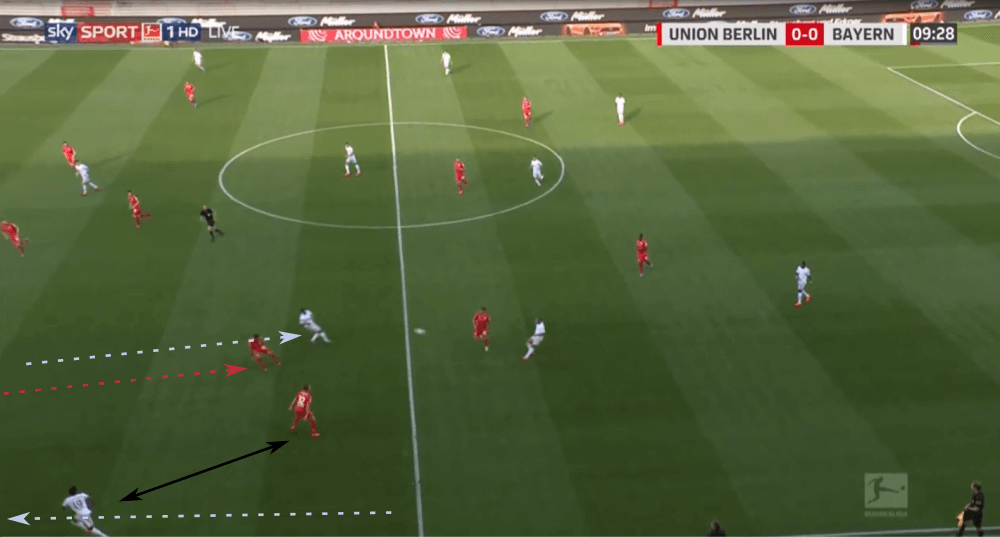
But it’s not just in the wide-areas such rotations can help, as they can be especially vital in the central areas as well. The space between the midfield and the defence is always important for the defending team since the attackers want to get exactly there. Bayern often successfully found Leon Goretzka (offensive midfielder) in this space since Thiago and Joshua Kimmich stayed deeper to lure out the two central midfielders of Union and Robert Lewandowski stayed higher to pin back the central defenders. We can see an example for that below. Also, notice that as soon as the ball is played, the right centre-back (Hübner) instantly rushes forward to press in at Goretzka.
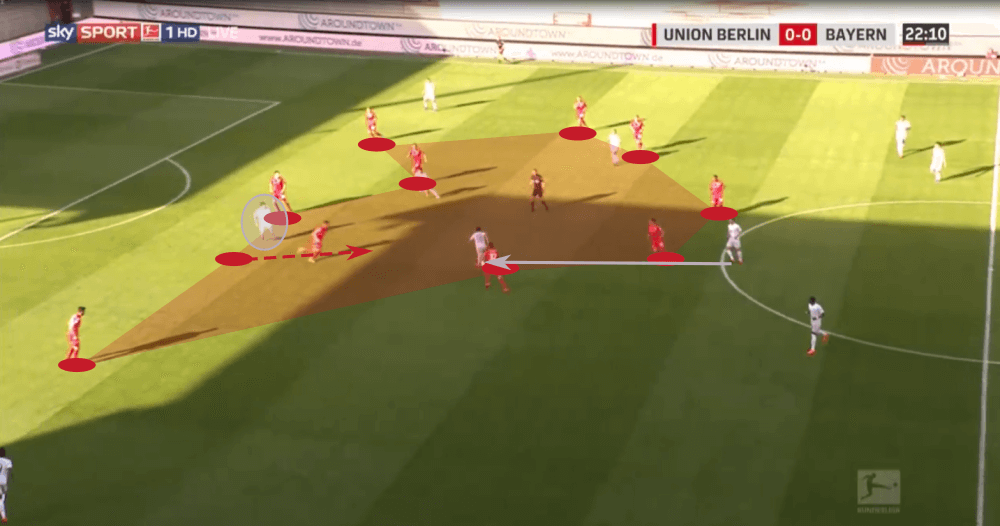
Basically, we can expect Union to defend deeper in their 5-4-1 and act quite man-orientated. Now, we will look at Hertha’s build-up principles and offensive tactics under their new coach Bruno Labbadia.
They stay in their 4-4-2 formation with a few asymmetric movements since Plattenhardt mainly stays deep and Mittelstädt is positioned near the touchline while on the other wing, the right-back Pekarík likes to rush forward when Lukébakio moves into the half-space. We can see these principles perfect in the shot below. Pekarík is positioned so high up the pitch that he is out of the frame.
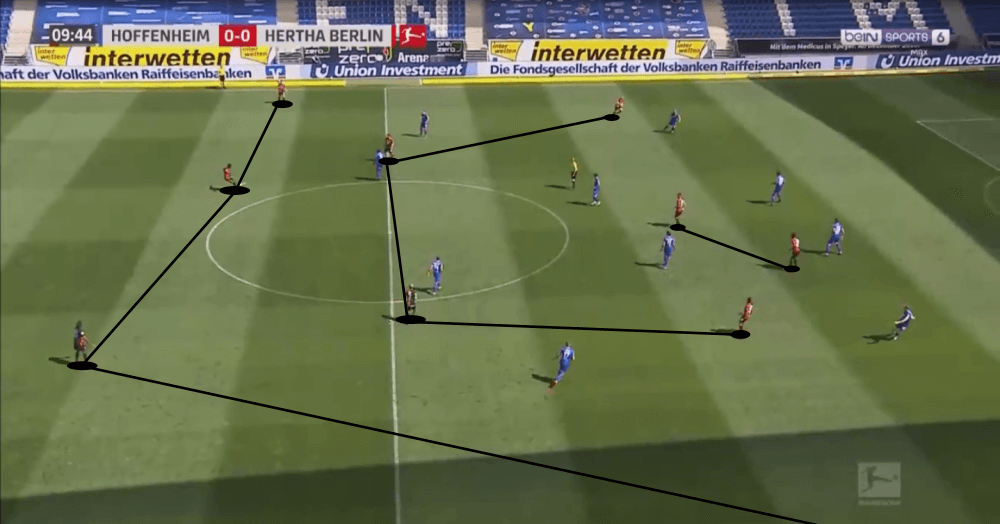
In general, they attack down these two flanks in a quite different way. On the right side Pekarík, Lukébakio, Grujić, and Cunha are more flexible, interchange positions, and try to use combinations; while on the left side they mainly attack down the wing to then cross the ball into the centre. There are several reasons for that since Mittelstädt is a natural wide-player while Lukébakio can also play in the centre, Plattenhardt is a full-back who mainly stays wide while Pekarík also likes to start underlapping runs. Grujić is more offensive orientated and more agile compared to Skjelbred and Cunha is more mobile compared to Ibišević.
This also can be seen in the numbers as Pekarík and Lukébakio together delivered one successful cross while Plattenhardt and Mittelstädt found a teammate with a cross three times (and the one which got cleared resulted in a goal by Pekarík). Also, the 2-0 by Ibišević was assisted by Mittelstädt with a perfect cross.
When they progressed the ball through the centre, Grujić and the two strikers were vital as their teammates tried to find them with vertical passes like the one in the image below.
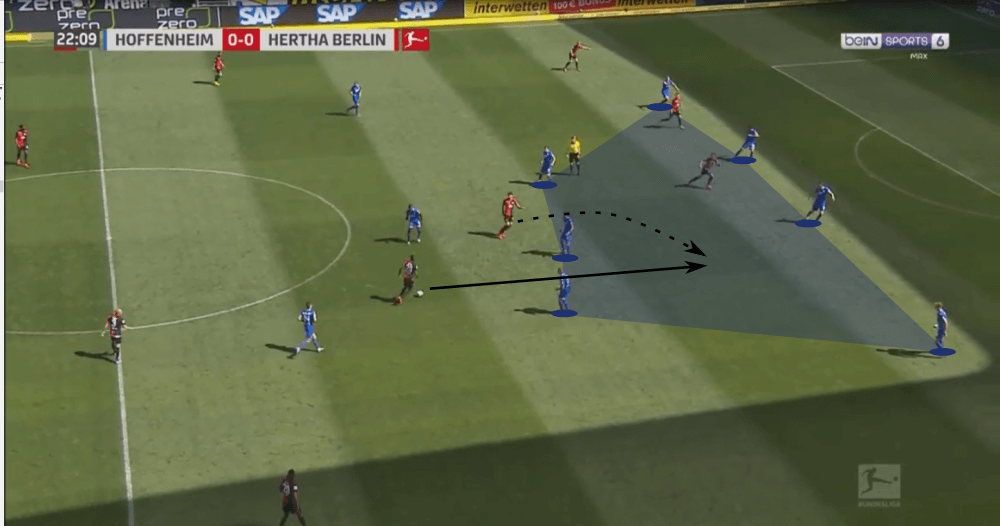
Considering all the tactics and aspects which got mentioned above, it will be vital for Hertha Berlin to use their typical rotations on the right side to create space in the defensive structure of Union Berlin which then they can exploit. If they play on the left side again so straight forward, I expect Union to control this wing easily with their man-orientation. In the shot below you can see what I expect to see during the majority of the match since Fischer’s team will sit back deeper and Hertha BSC will use rotations on the right to either break through there or find a striker in the space in front of Union’s defence.
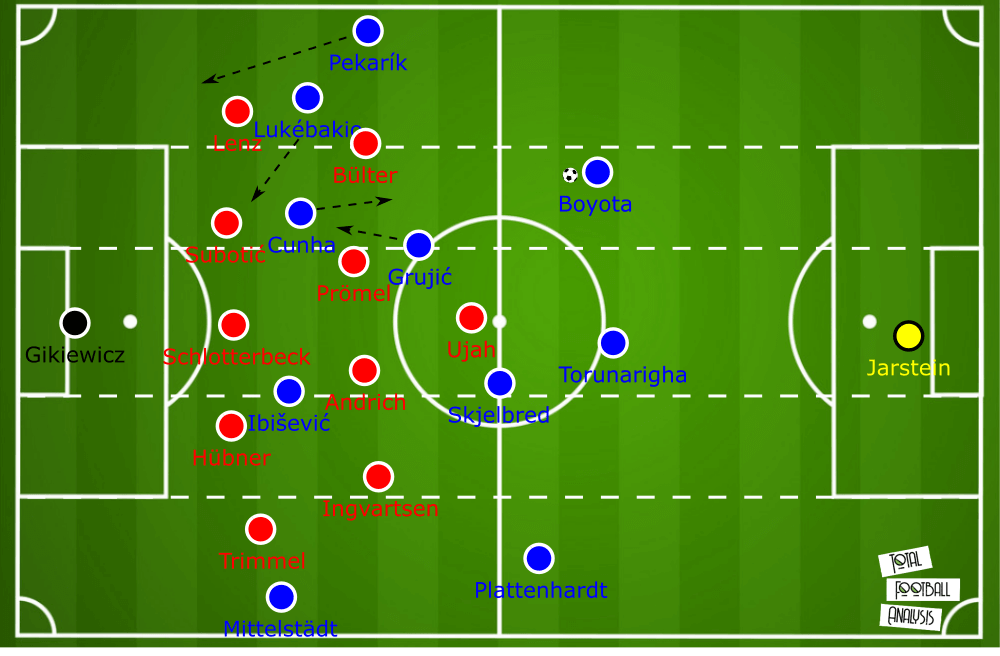
Long balls and verticality as central patterns for Union
Now, we will talk about the offensive principles of Fischer’s side and what this might mean for Hertha’s defence. Basically, the two central elements of their tactics for the progression are long balls and verticality. They mainly try to get quite quickly into the final third to then either reach the space behind the opposition’s defence or get a freekick/corner (14 out of their 32 goals in this season resulted out of set-pieces). Almost all of their goal kicks are played long as we can see in the situation below against Bayern.
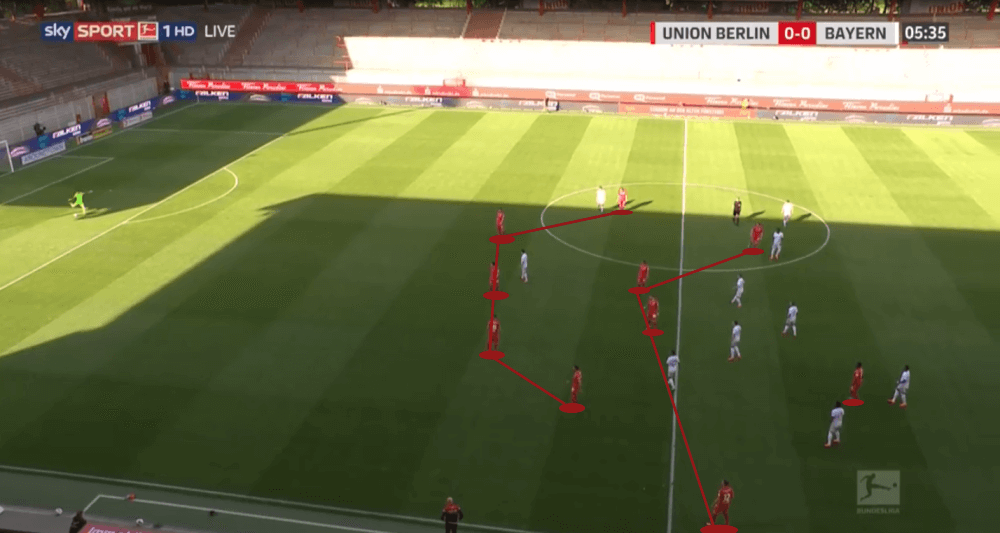
Whenever Ujah is their single striker like in their last clash with Bayern Munich, they either try to find him with long balls and he should then lay them off for the wingers and central midfielders, or they try to find him with through passes. The 29-year-old Nigerian is solid in the air and is fast (clearly quicker than Andersson), but in none of these two categories is he incredibly outstanding.
In the image below we can see an example for such a through pass as Ujah intelligently positions himself between the centre-backs of Bayern to the start the sprint. The pass finds the striker, but his shot goes wide.
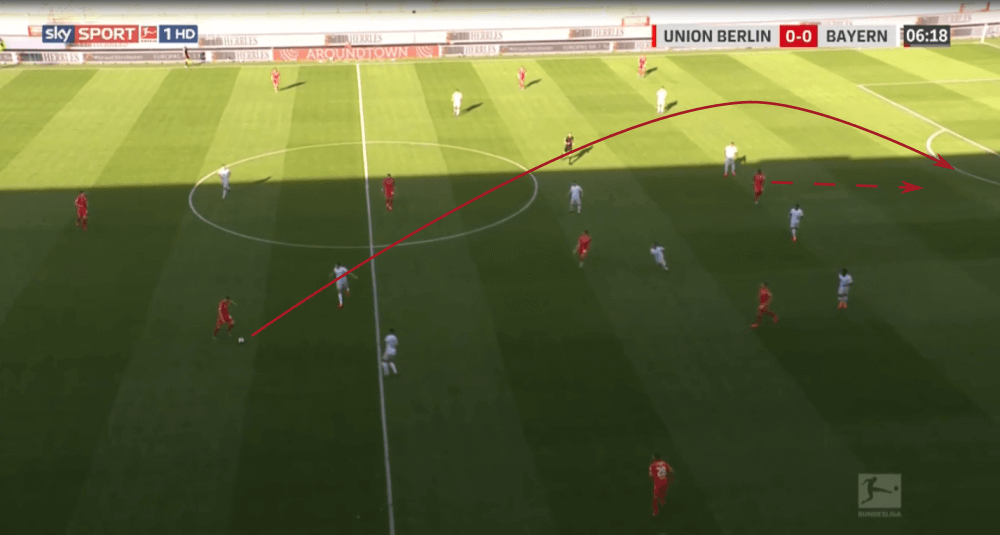
As mentioned in the first section of this tactical analysis and preview, the most likely change would be that Andersson will replace Ujah. The Swedish striker is better in the air compared to his Nigerian teammate, but on the other hand, he is quite slow. So, he is more dominant in the air, but at the same time, it makes no sense to try to find him with through passes. In the shot below we can see an example in which they play a long ball towards Andersson.
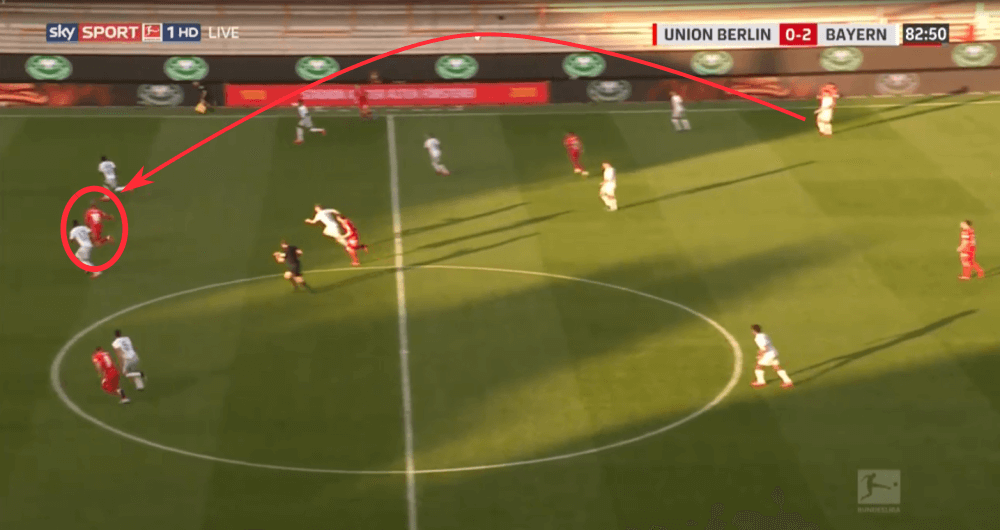
On the other side, we saw in the first match under Labbadia that Hertha tried in several moments to press in at their opponents earlier and higher up the pitch. After the 90 minutes, they had a value for PPDA (passes per defensive action) of 8.2, which was clearly lower than Hoffenheim’s 11.8 in this game or Union’s 15.4 in the match against Bayern. The interesting thing about their press was that they tried to force Hoffenheim into the centre where they then started the actual press. It was mainly Ibišević who marked the option for a pass back to the centre-back and so he forced them into the centre where then Cunha (and the central midfielders) started to put pressure on the opposition.
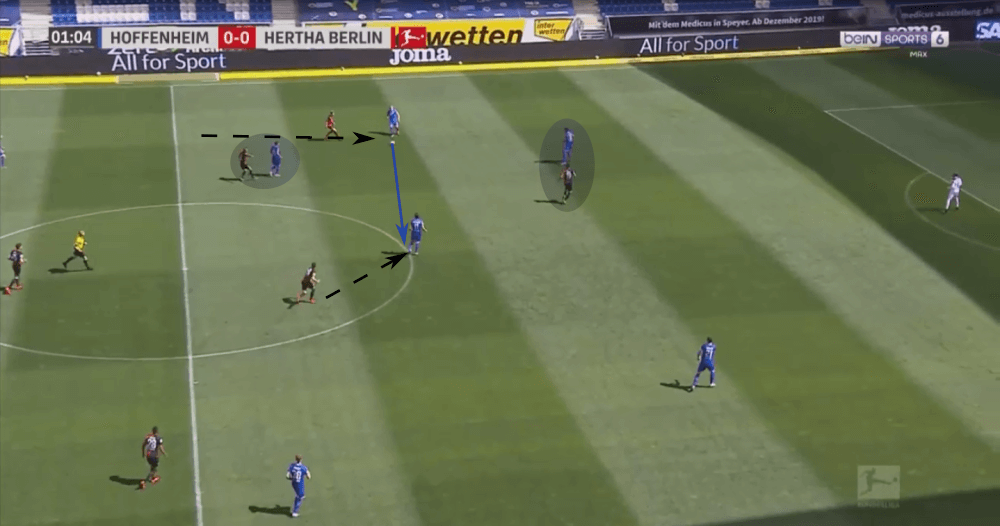
During the press, Hertha was quite man-orientated which sometimes led to situations like the one below in which Grujić was suddenly alone in the centre since all other players (who executed the actual press) followed their opponents.
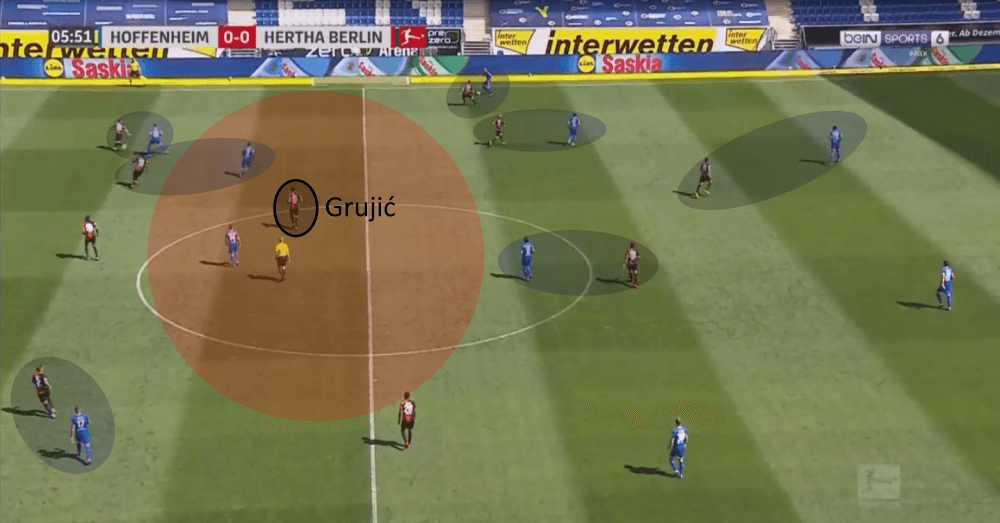
Union Berlin will again mainly operate with long balls and the kind of them will depend on if Ujah or Andersson will play. Maybe Union will try to lure Skjelbred out of the centre and then play a long ball since then Grujić is the only player of Berlin in the area where the fight for the second ball will take place.
Counter-attacks as decisive elements?
Since Union rarely uses a counter-press and Hertha only occasionally does, the counter-attacks could be important elements in this game. At this stage, you need to mention that this is just the second game for the players after a long break (without a perfect preparation) and due to that, the intensity will be again not as high for 90 minutes as it was before the break. Still, the moments of offensive transition could be interesting, especially since both teams use different approaches in this phase.
Hertha Berlin always try to find Ibišević with the first or second pass after they have won the ball. The 35-year-old then lays the ball off for one of the central midfielders or wingers and then the goal is to exploit the space of Cunha, Lukébakio, and Mittelstädt. He prepares already for that during the defensive phase as he clearly stays higher compared to Cunha (first image) and in the second one, we have an example for a situation in which they find him with a long ball at the beginning of a counter-attack.
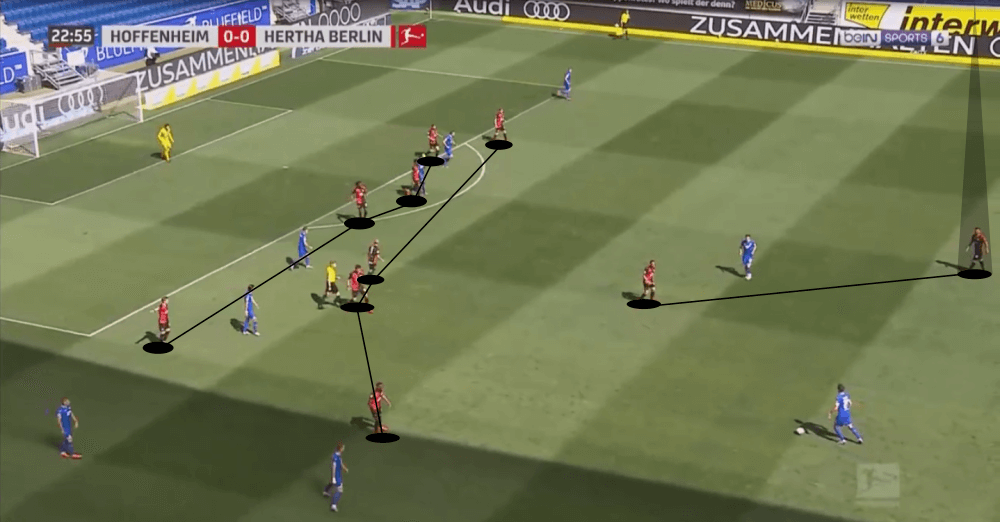
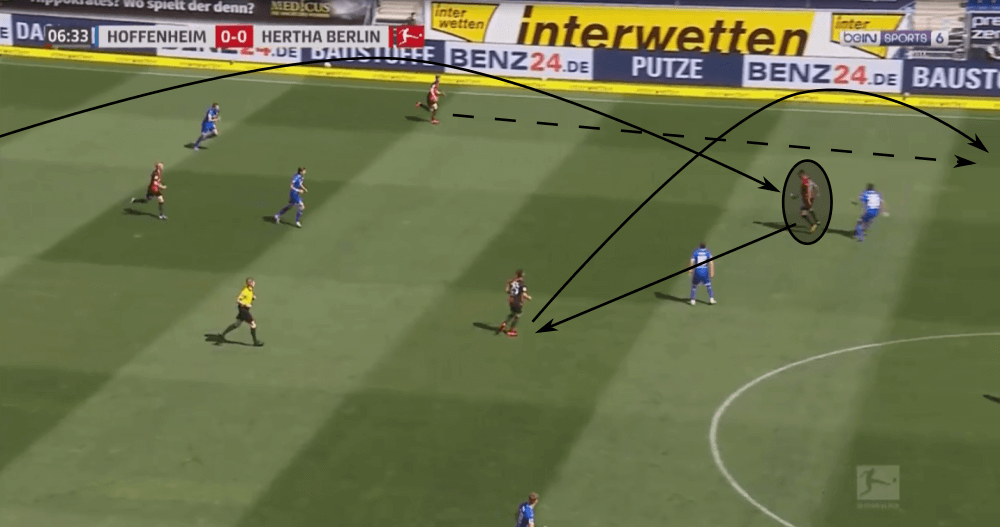
On the other side, Union Berlin instantly tries to play vertical behind the last line of the opposition. In light of that, Ujah is in the offensive transition definitely more deadly than Andersson. In the shot below we can see an example from the game against Bayern. Moments ahead, Union Berlin won the ball and the striker (Ujah) and the left-winger (Bülter) instantly start their deep runs. However, they got ruled offside.
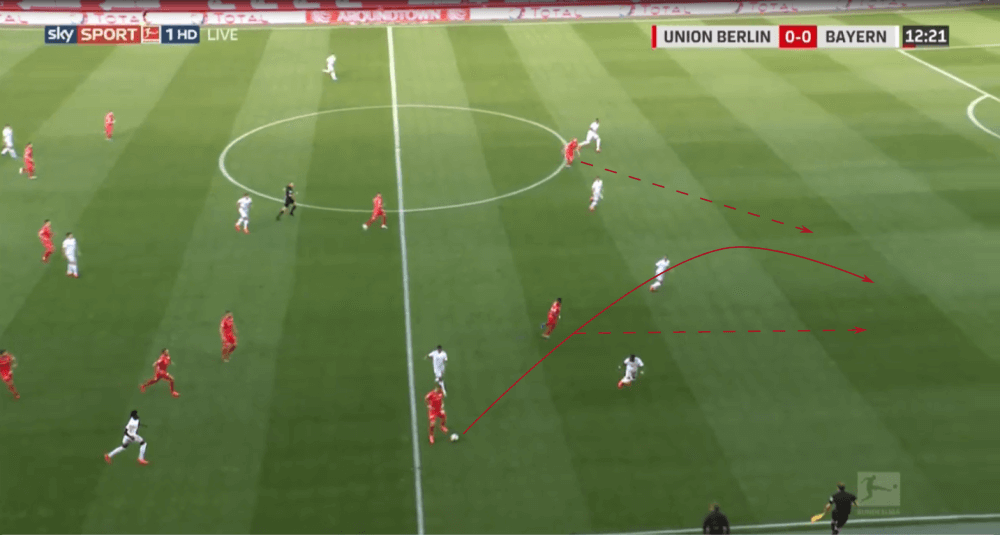
Conclusion
The central question ahead of this game is if Hertha Berlin can use rotations as intelligently as Bayern did. Especially with their individual class on the right side, this could be really interesting to watch. We can expect a tight game as I expect both teams are on about the same level since the results of the last weekend’s games don’t tell the whole truth. Hertha Berlin won 3-0, but the game was evenly matched (Hoffenheim had an xG-value of 2.25 but missed so many chances). On the other side, Union Berlin was quite solid against Bayern who needed a penalty and a goal after a corner to win the match 2-0.
Also, as a final point, I want to note that Hertha defended quite badly in their last match during set-pieces and these are exactly one of the strengths of Union. Because of that, these aspects could be the decisive situations in this derby of Berlin.





Comments